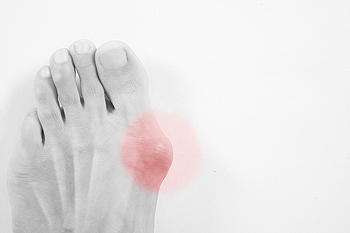
Lansdowne, PA
(610) 626-3338

Lansdowne, PA
(610) 626-3338
 A bony protrusion on the bottom of the big toe may be diagnosed as a bunion. It can occur as a result of genetic factors, or from wearing shoes that do not have adequate room for the toes to move freely in. The medical term for this condition is known as hallux valgus, and it can force the big toe to bend to the side. Some of the symptoms that are often associated with this condition can consist of pain, swelling on or around the affected toe, and arthritis may gradually develop. Moderate relief may be found if a padded bandage is worn over the bunion. This may help to protect it from rubbing against the side of the shoe, and it may be beneficial to refrain from wearing shoes that have a pointed toe area. If you feel you have developed a bunion, it is advised that you speak with a podiatrist who can properly treat this condition.
A bony protrusion on the bottom of the big toe may be diagnosed as a bunion. It can occur as a result of genetic factors, or from wearing shoes that do not have adequate room for the toes to move freely in. The medical term for this condition is known as hallux valgus, and it can force the big toe to bend to the side. Some of the symptoms that are often associated with this condition can consist of pain, swelling on or around the affected toe, and arthritis may gradually develop. Moderate relief may be found if a padded bandage is worn over the bunion. This may help to protect it from rubbing against the side of the shoe, and it may be beneficial to refrain from wearing shoes that have a pointed toe area. If you feel you have developed a bunion, it is advised that you speak with a podiatrist who can properly treat this condition.
If you are suffering from bunion pain, contact Dr. George Yarnell of Pennsylvania. Our doctor can provide the care you need to keep you pain-free and on your feet.
What Is a Bunion?
Bunions are painful bony bumps that usually develop on the inside of the foot at the joint of the big toe. As the deformity increases over time, it may become painful to walk and wear shoes. Women are more likely to exacerbate existing bunions since they often wear tight, narrow shoes that shift their toes together. Bunion pain can be relieved by wearing wider shoes with enough room for the toes.
Causes
Symptoms
In order to diagnose your bunion, your podiatrist may ask about your medical history, symptoms, and general health. Your doctor might also order an x-ray to take a closer look at your feet. Nonsurgical treatment options include orthotics, padding, icing, changes in footwear, and medication. If nonsurgical treatments don’t alleviate your bunion pain, surgery may be necessary.
If you have any questions, please feel free to contact our office located in Lansdowne, PA . We offer the newest diagnostic and treatment technologies for all your foot care needs.